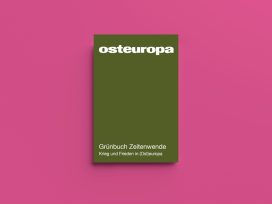 The fall of communism in central Europe has brought a very clear ideological demand for the revival of the middle class project. At the same time, the new economic system has actually started to produce a new social group that could technically be considered a middle class. Positivist sociologists who define the middle class in terms of income and occupation have immediately started to note the development of this new formation. It was supposed to replace both the old intelligentsia and its communist variants, including the “working intelligentsia” or the technocrats. This view, inspired by modernization theory, assumed that the rise of the middle class and the final demise of the intelligentsia are both determined by the logic of the post-communist transformation, which will inevitably make the social hierarchies of central Europe similar to those observed in western European societies.
The fall of communism in central Europe has brought a very clear ideological demand for the revival of the middle class project. At the same time, the new economic system has actually started to produce a new social group that could technically be considered a middle class. Positivist sociologists who define the middle class in terms of income and occupation have immediately started to note the development of this new formation. It was supposed to replace both the old intelligentsia and its communist variants, including the “working intelligentsia” or the technocrats. This view, inspired by modernization theory, assumed that the rise of the middle class and the final demise of the intelligentsia are both determined by the logic of the post-communist transformation, which will inevitably make the social hierarchies of central Europe similar to those observed in western European societies.
It is difficult to assess the degree to which this process is producing the expected result. Any attempt at such an assessment could always be seen as an intervention in the ideological confrontation between the identity projects of a class, which are at the same time linked to particular interpretations of social structure. Thus, on the one hand, we have the aforementioned functionalist sociologists and their allies in other fields, who look at societies of central Europe through the lens of classic western sociological models, which are considered as patterns to follow. They can already discern large crowds of new middle class members in the region, with many more central Europeans on their way to joining them. On the other hand, we have the no less influential guardians of the intelligentsia, both liberal and traditionalist, who argue over the continuing relevance of the intelligentsia. The guardians of the old intelligentsia identity are to be found in all parts of the elite; however, they are most numerous in its cultural wing. Its proponents argue that the identity of the intelligentsia can be seen as a historically contextualized form of the middle class in central Europe. They suggest that anyone aspiring to elite membership of the contemporary middle class, or the upper middle class, should, in the central European context, also identify as part of the intelligentsia.
This widespread insistence on the relevance of the intelligentsia identity does not mean that there is no criticism of the intelligentsia, and its identity, heritage and uses. These two apparently contradictory trends, which seem to serve the reinforcement of the intelligentsia identity, are particularly visible in Poland. Most critiques of the intelligentsia are in fact by intelligentsia members themselves, and what they criticize is usually competing intelligentsia projects and particular intelligentsia factions. This trend can be contrasted with the Russian situation, where there is no lack of voices condemning the intelligentsia as such. In the Polish case, however, those moving upward or horizontally towards occupations related to the business sector are exposed to overlapping pressures. On one hand, they are confronted with still influential intelligentsia discourses promoting specific values, lifestyles and social milieus. Those aspiring to a higher social position are thus expected not only to be successful in material terms, but to be “cultured” according to intelligentsia standards. Those not fulfilling these expectations may hear caustic remarks about the “newly-educated”, who do not deserve to be called “true intelligentsia members”, but should rather be called the nouveau riche. On the other hand, expectations on new middle class members are based on the direct import of western middle class models, images and lifestyles.
Without taking on a typical defence of the intelligentsia, I would argue that some degree of historical and cultural contextualization appears indispensable for the development of the identity for those aspiring to assume the role of members of a middle class. Mere imitation of the western identities leads to situations where aspiring middle class members are put in a disadvantaged position both in relation to their national competitors, the intelligentsia, as well as to their western counterparts, who will always enjoy being a superior role model. Identity strategies based on direct imitation may expose the weakness of the new middle class not only in terms of mastery of higher culture, but also lack of mastery of western culture, intimate knowledge of which becomes indispensable in such a situation. One could find several other reasons for why a project of development of an endogenous middle class identity rooted in the historical heritage of the region seems needed. The question is, of course, what kind of heritage such an identity could allude to. In other words, who should be chosen by the new middle class as its ancestors?
In any case, this kind of identity will largely be an arbitrary reconstruction, since the degree of continuity between the pre-war and post-communist era bourgeois elites is very small. Among current attempts at the reconstruction of the middle class non-intelligentsia project in Poland is Pawel Kubicki’s report entitled “New Burghers” (Nowi Mieszczanie). Published in 2009, it sparked a wide discussion. Kubicki argued that “the new burghers” in the milieu of young Poles who have gradually moved from the countryside to major cities are creating a completely new urban stratum, which could be considered the future model of the Polish middle class. Kubicki criticized intelligentsia traditions and argued that the intelligentsia’s mission is over. His choice of the towns of Krakow, Szczecin and Wroclaw was probably not accidental, since these cities belong to two specific historical regions of Poland. Krakow is located in the southern part of Poland, which was controlled by Austria in the nineteenth century. Until 1945, Szczecin and Wroclaw not only belonged to Germany and earlier Prussia, but were practically entirely German-speaking towns. Wroclaw is the most positive case in Kubicki’s report, which quotes young citizens of the city declaring a sense of common identity with the pre-war inhabitants of Breslau. According to Kubicki, this is the way the present-day Wroclaw middle class elite is able to get rid of eastern European and post-communist inferiority complexes and create a new, open, European and regionally-rooted middle class modern identity, breaking with the burden of the old intelligentsia myths.
High degree of arbitrariness and loose, indirect historical linkage with the present day urban life is particularly problematic in this identity project. The linkage is mostly based on the regional dimension, which in the case of cities like Breslau/Wroclaw is largely restricted to the geographical and material dimension. Given the almost total replacement of the pre-war German population by the Polish settlers and the vestigial size of the town’s Polish community before the war, it is difficult to talk about any substantial cultural, institutional or social continuity between the pre-war bourgeoisie of Breslau and the new middle class of Wroclaw. In fact, this regional project seems to be not much more than another attempt at the imitative reconstruction of western middle class culture and identity legitimized by the narratives of urban history.
One can note that similar endeavors have tended not to appear in the eastern part of Poland. However, it is in eastern Poland, and more precisely in the former Russian sector of the nineteenth-century division of the Polish lands, where one can look for patterns and inspiration for those trying to meet the challenges of the integration of the Polish middle class project with a wider international community. One reason for this is that contemporary mainstream images of the former Russian zone of Poland are mostly very negative. The entire eastern part of Poland is considered to be backward due to the heritage of Russian rule until 1915. This dominating image of the region’s history usually ignores the fact that in the second half of the nineteenth century it became one of the fastest developing parts of the Russian empire and. In effect, its urban and industrial centres surpassed the two other divisions of Polish lands: the one under Austrian rule (Galicia) and the other under Prussian occupation (Greater Poland). The cities of Bialystok, Sosnowiec, Lódz and Warsaw developed at a spectacular pace. Warsaw became the third metropolis of the Russian Empire and in all these urban centres the bourgeoisie grew in numbers and in wealth. To be sure, a major portion of the capital, on the basis of which the region was developing, came from outside; the new capitalist class was largely non-Polish in ethnic terms. At the same time, a large percentage of the Polish elite was developing in the framework of the intelligentsia identity, emphasizing the superiority of the post/neo-gentry values over bourgeois ideals. Nevertheless, there was a clear group of Polish urbanites advancing rapidly in social and economic terms.
Simultaneously, many had been developing hybrid identities. They included Jewish, German, Russian and other roots and loyalties that were competing and interfering inside particular groups, families or even individually. Two famous Polish novels immortalized the images of these processes of complex social transformations and emergence of the Polish bourgeoisie. They are The Doll by Boleslaw Prus and The Promised Land by Wladyslaw Reymont; both featured stories of successful business people making their careers under Russian rule. However, besides these spectacular, but exceptional, histories of the development of the Polish bourgeoisie under the late Russian Empire, the entire memory of the Russian-controlled Poland has been lost and is currently blurred by dominating narratives of the Russian political oppression and Polish resistance to it. It includes both everyday opposition to Russification as well as periodical military uprisings, which occupy a prominent place in Polish narratives of nineteenth century national history.
One could also speculate that it is not only because of its “eastern connection” that the heritage of the rising business class in the Polish part of the Russian Empire has been largely forgotten. It could also be linked to the Bolshevik Revolution, which annihilated the economic system of the Russian Empire and destroyed the careers of almost all of its business elite. This was also the fate of a large percentage of the Polish bourgeoisie and a significant number of urbanites, who lost their savings and property that appeared to be located east of the border that the Soviet Union set by the Riga Treaty. Polish landowners also suffered major losses with the victory of the Bolsheviks; however, they retained most of their lands inside the newly independent Poland until the Second World War. The blow to the bourgeoisie was much more painful, since they were part of the dynamic economic and financial systems of the Empire with major nodes in St Petersburg and Moscow. The cities of Warsaw or Lódz were not able to regain their pre-revolutionary economic dynamic; for the political elite of inter-war Poland, this was the period of the rise to power of the intelligentsia. Their identity was built primarily on myths of patriotic movements, suffering under foreign domination, and stories of the resistance. To this day, the end of the First World War has been identified with Poland regaining independence in 1918, which continues to play the role as the crucial positive event in the nation’s history. There is no mention of the economic catastrophe for most of the business elite, as well as the elite landowners of Poland. For many of their members who remained in the Soviet Union after 1918, these tragedies were not only economic, they involved extensive persecution, including imprisonment and execution.
Reviving some of their memories may appear useful from the point of view of the aforementioned project of development of an indigenous middle class identity. In contrast to the bourgeoisie of Breslau or Stettin, the bourgeoisie of pre-1915 Lódz and Warsaw were in many ways integrated into Polish society. The same could be said about the numerous Poles making their careers in central Russia or Siberia. The stories of their careers, businesses and families are often fascinating and inspiring in many dimensions. One of these is intercultural dialogue and integration. In particular, this goes for the Polish-Jewish families who represented a considerable part of the economic elite of the time. Among them were families such as Wawelberg or Kronenberg, famous for their crucial role in the development of the banking system and industry. Today, Polish-Jewish dialogue is considered an important element of development of the civil society in Poland and the revival of the heritage of Polish Jews is considered a priority of state memory policy. One could note that the dominating narrative of the memory of the pre-war Jewish heritage in contemporary Poland is skewed towards motives of the provincial Jewish shtetls, usually inhabited by poorer and more traditional, religious communities. The memory of the successful Polish-Jewish business people, usually more or less secularized and Polonized or Russified, appears to be marginalized. They were, however, an essential part of the core emerging bourgeoisie of the Russian part of Poland. The revival of the memory of their achievements, failures, and dilemmas could thus be instrumental both as an inspiration for the new middle class project in contemporary Poland, as well as for fostering Polish-Jewish dialogue.
A rare example of recalling the memory of that heritage is the Handlowy Bank in Warsaw. It is the second oldest Polish commercial bank, set up in 1870 by a group of investors under the leadership of Leopold Kronenberg. Currently, the bank tends to emphasize its westerness by pointing out its American ownership, with City Group as the major stakeholder, and using the name of “Citi Handlowy”. However, it is also slowly rediscovering the power of its Russia-related heritage. The Kronenberg Fund (Fundacja Kronenberga) set up by the Bank Handlowy highlights the spectacular career of Kronenberg on its website. What is also emphasized is the bank’s “ability” to cooperate with Polish landowners, as well as the Russian “authorities” and Polish patriots. It has also recently supported the publication of the biography of the Kronenberg Family.
One could, of course, argue that such memory projects are no less arbitrary than others, and that their potential for mobilization, in particular, their chances of resonating with the new middle class identity, is minimal. One could also, however, quote at least one example of special power of inspiration of the memory of the bourgeoisie of the late Russian Poland. This is the case of an intriguing declaration of the CEO of one of the most successful, technologically-advanced contemporary Polish companies – the bus-maker “Solaris Bus & Coach”. Solaris buses and trams are a rare case of a Polish brand known in several countries around the world; their vehicles can be seen on the streets of Abu-Dhabi to Sweden. Solange Olszewski, a co-founder of the company, has repeatedly said that one of the key inspirations that motivated her and her husband to undertake such an ambitious project in Poland was the aforementioned novel The Promised Land by Wladyslaw Reymont. The title of the book refers to the city of Lódz and its dynamic growth in the late nineteenth century. The Reymont novel clearly foregrounds the spectacular growth and opportunities that appeared in this unique city during the late Russian Empire. The fact that contemporary Polish business people find in it a source of self-confidence may be seen as a sign of the hidden potential in other narratives of the successful Polish entrepreneurs in Russian Poland. They can be much more inspiring for the new Polish middle class as role models, given their embeddedness in Polish history, which makes them much more familiar. Besides the inspiration provided by the successful stories of ancestors, they offer a rich stock of stories that introduce the dilemmas that the pioneers of capitalism were faced with. Many of them are still valid, even if in somewhat new forms. Among them, one might mention the dilemmas of conflict between national interests and global capital, the accusation of serving foreign interests, and the need for maneouvering between state and private institutions.
The very question of relations between the intelligentsia and middle class identities can also be related to the history of the late Russian Poland. They include tensions between the two sides of the landed gentry and the aristocratic elite, a major part of which transformed into the intelligentsia and the emerging bourgeoisie. That tension has even older roots, going back to the pre-partition period, when the Polish nobility curtailed the rise of the Polish burghers. In fact, this continued until the inter-war period. In any case, this way of relating contemporary middle class identity with the historical past does seem to provide an alternative source of confidence to the new economic elites, who may choose to depart from the traditional intelligentsia projects. At the same time, turning the interests of the new middle class towards the heritage of their ancestors in eastern Poland could encourage mutual understanding between Poland and Russia, and more broadly, Poland’s process of coming to terms with its non-Polish heritage – in this case mostly Jewish, Russian and German.

 The fall of communism in central Europe has brought a very clear ideological demand for the revival of the middle class project. At the same time, the new economic system has actually started to produce a new social group that could technically be considered a middle class. Positivist sociologists who define the middle class in terms of income and occupation have immediately started to note the development of this new formation. It was supposed to replace both the old intelligentsia and its communist variants, including the “working intelligentsia” or the technocrats. This view, inspired by modernization theory, assumed that the rise of the middle class and the final demise of the intelligentsia are both determined by the logic of the post-communist transformation, which will inevitably make the social hierarchies of central Europe similar to those observed in western European societies.
The fall of communism in central Europe has brought a very clear ideological demand for the revival of the middle class project. At the same time, the new economic system has actually started to produce a new social group that could technically be considered a middle class. Positivist sociologists who define the middle class in terms of income and occupation have immediately started to note the development of this new formation. It was supposed to replace both the old intelligentsia and its communist variants, including the “working intelligentsia” or the technocrats. This view, inspired by modernization theory, assumed that the rise of the middle class and the final demise of the intelligentsia are both determined by the logic of the post-communist transformation, which will inevitably make the social hierarchies of central Europe similar to those observed in western European societies.




